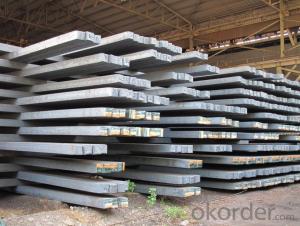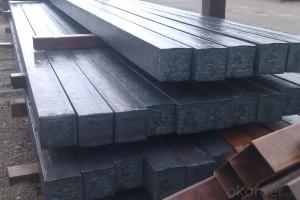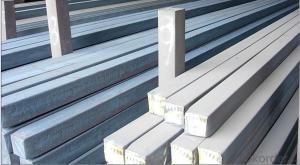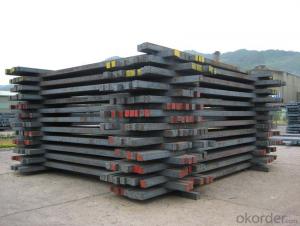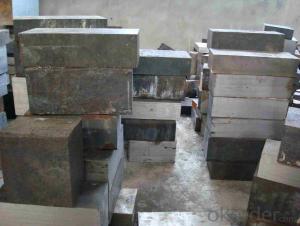Hot Rolled Square Steel Billet 3SP Standard 125mm
- Loading Port:
- Shanghai
- Payment Terms:
- TT OR LC
- Min Order Qty:
- 2000 m.t.
- Supply Capability:
- 10000 m.t./month
OKorder Service Pledge
OKorder Financial Service
You Might Also Like
Structure of Hot Rolled Square Steel Billet 3SP Standard 125mm

Description of Hot Rolled Square Steel Billet 3SP Standard 125mm
PPGI is made by cold rolled steel sheet and galvanized steel sheets as baseplate, through the surface pretreatment (degreasing, cleaning, chemical conversion processing), coated by the method of continuous coatings (roller coating method),
and after roasting and cooling. Zinc coating: Z60, Z80, Z100, Z120, Z180, Z275, G30, G60, G90
Alu-zinc coating: AZ60, AZ80, AZ100, AZ120, AZ180, G30, G60, G90
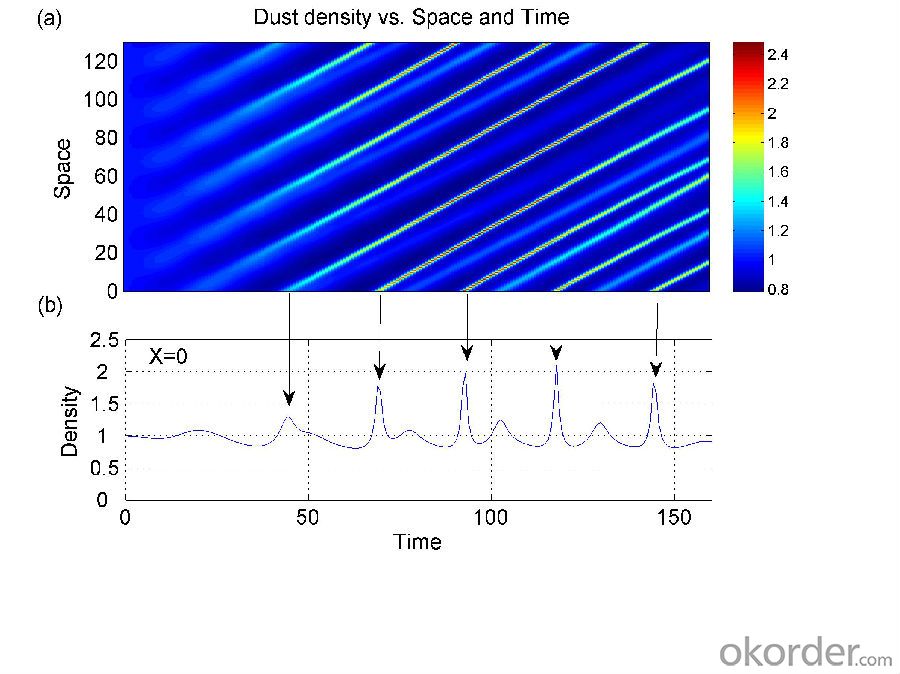
Main Feature of Hot Rolled Square Steel Billet 3SP Standard 125mm
1) Excellent corrosion resistance: The zinc layer provides a good protection of Pre-painted Galvanizeed Steel Sheet.
2) High heat resistance: The reflective surface of the material aids in efficiently reflecting the sunlight away and in turn reducing the amount of heat transmitted. The thermal reflectivity converts into energy savings.
3) Aesthetics: Pre-Painted Galvanized steel sheet is available in plethora of patterns and multiple sizes as per the requirements that given by our customers.
4) Versatility: can be used in the various areas.Standard seaworthy export packing: 3 layers of packing, inside is kraft paper, water plastic film is in the middle and outside GI steel sheet to be covered by steel strips with lock, with inner coil sleeve.
Applications of Hot Rolled Square Steel Billet 3SP Standard 125mm
1) Automotive bodies: filters, fuel tanks, etc.
2) Construction materials: roofings, welding pipes,
3) Electric and electronic appliances: computer cans, etc.
4) Steel cans: containers, etc.
5) Steel furniture: washing machines, refrigerators, microwaves, etc.
6) Drums
7) Office equipment: printer, recorders, etc.
8) Motors and transformers

Specifications of Hot Rolled Square Steel Billet 3SP Standard 125mm
| Classified symbol | Yield Point Minimum N/mm2 | Tensile Strength Minimum | Elongation Minimum % | Application | ||||
| N/mm2 | Nominal Thickness mm (t) | |||||||
| JIS | Yogic | 0.25-0.4 | 0.4-0.6 | 0.6-1.0 | 1.0-1.6 | |||
| G3312 | specification | |||||||
| CGCC | CGCC | -205 | -270 | -20 | -21 | -24 | -24 | Commercial |
| CGCD | CGCD | --- | 270 | --- | 27 | 31 | 32 | Drawing |
| --- | CG340 | 245 | 340 | 20 | 20 | 20 | 20 | Structural |
| CGC400 | CG400 | 295 | 400 | 16 | 17 | 18 | 18 | Structural |
| CGC440 | CG440 | 335 | 440 | 14 | 15 | 16 | 18 | Structural |
| CGC490 | CG490 | 365 | 490 | 12 | 13 | 14 | 16 | Structural |
| CGC570 | CG570 | 560 | 570 | --- | --- | --- | --- | Structural |
| ASTM Designation | Yield Point Minimum | Tensile Strength Minimum | Elongation Minimum % | Application | Q/BQB 445-2004(China standard) | ASM A653/A653M | JISG 3312 | |
| ksi(MPa) | ksi(MPa) | TDC51D+Z | (CS TYPE A+Z) | CGCC | ||||
| A653(M)-99 CS TYPE A,B,C | --- | --- | --- | Commercial | TDC52D+Z | CGCD | ||
| A653(M)-99 FS | --- | --- | --- | Lock Forming | TS250GD+Z | (G250+Z) | - | |
| A653(M)-99 DS | --- | --- | --- | Drawing | TS300GS+Z | (G300+Z) | CGC 400 | |
| A653(M)-99 SS Grade33(230) | 33(230) | 45(310) | 20 | Structural | TS350GD+Z | (G350+Z) | CGC490 | |
| A653(M)-99 SS Grade37(255) | 37(255) | 52(360) | 18 | Structural | TS550GD+Z | (G550+Z) | CGC570 | |
| A653(M)-99 SS Grade40(275) | 40(275) | 55(380) | 16 | Structural | ||||
| A653(M)-99 SS Grade50(345) | 50(345) | 65(450) | 12 | Structural | ||||
| A653(M)-99 SS Grade80(550) | 80(550) | 82(570) | --- | Structural | ||||
FAQ of Hot Rolled Square Steel Billet 3SP Standard 125mm
We have organized several common questions for our clients,may help you sincerely:
1. How Can I Visit There?
Our company is located in Tianjin City, China, near Beijing. You can fly to Tianjin Airport Directly. All our clients, from home or aboard, are warmly welcome to visit us!
2. How Can I Get Some Sample?
We are honored to offer you sample.
3. Why choose CNBM?
1, ISO, BV, CE, SGS approved.
2, Competitive price and quality.
3, Efficient service team online for 24 hours.
4, Smooth production ability(50000tons/month) .
5, quick delivery and standard exporting package.
6, Flexible payment with T/T, L/C, Paypal, Kunlun bank, etc.
- Q:Can steel billets be used in the production of jewelry?
- Due to its composition and properties, steel billets are usually not utilized in jewelry production. Steel, which is primarily made up of iron and carbon and contains additional elements like manganese, chromium, and nickel, possesses strength and durability that make it well-suited for various industrial applications, but not for crafting jewelry. In contrast, jewelry is typically crafted from precious metals like gold, silver, and platinum, which possess unique characteristics that make them suitable for adornment. These metals are easily shaped and molded into intricate designs due to their malleability. Moreover, they have a lustrous appearance and are resistant to tarnishing or corrosion. On the other hand, steel is much harder and less malleable compared to precious metals. It cannot be easily manipulated into the delicate and intricate shapes required for jewelry making. Additionally, steel has a dull gray color that does not offer the desired aesthetic appeal in jewelry. While it is technically possible to create jewelry using steel billets, it is not a common practice due to the aforementioned reasons. Steel is primarily utilized in industries where its high strength and durability are necessary, such as construction, automotive, and machinery manufacturing.
- Q:How do steel billets contribute to the manufacturing of renewable energy systems?
- Steel billets play a crucial role in the manufacturing of renewable energy systems by providing the necessary foundation for various components. These billets are essentially semi-finished steel products that are cast into a specific shape, making them highly versatile and adaptable to different renewable energy applications. One of the primary ways steel billets contribute to the manufacturing of renewable energy systems is through the construction of wind turbines. Wind turbines require a robust and stable structure to support the blades and the generator. Steel billets are used to create the tower, which serves as the backbone of the wind turbine. These towers need to withstand extreme weather conditions and support the weight of the blades, making the strength and durability of steel crucial. Similarly, steel billets are used in the manufacturing of solar energy systems, particularly in the production of photovoltaic (PV) panels. Steel frames are utilized to provide structural support for the PV panels, ensuring they are securely mounted and can withstand various environmental conditions. Additionally, steel billets are used in the manufacturing of solar trackers, which optimize the positioning of PV panels to maximize energy generation by following the sun's path throughout the day. Moreover, steel billets contribute to the production of hydroelectric power systems. In hydroelectric power plants, large turbines are used to convert the energy from flowing water into electricity. These turbines require sturdy and reliable components, including shafts and other mechanical parts that are often made from steel billets. The high strength and resistance to corrosion of steel make it an ideal material for these applications. Furthermore, steel billets are utilized in the manufacturing of energy storage systems, such as batteries. These billets are employed to create durable and secure enclosures for the batteries, ensuring their protection and safe operation. Steel's ability to withstand high temperatures and its resistance to fire make it a suitable choice for battery housing and containment. In summary, steel billets are essential in the manufacturing of renewable energy systems as they provide the strength, durability, and versatility required for various components. Whether it is wind turbines, solar panels, hydroelectric turbines, or energy storage systems, steel billets play a crucial role in enabling the reliable and efficient generation of renewable energy.
- Q:What are the different types of steel billet manipulation equipment?
- In the steel industry, there exists a variety of steel billet manipulation equipment. These machines serve the purpose of handling and manipulating semi-finished steel billets, which later undergo further processing to acquire different shapes and forms. The types of steel billet manipulation equipment are as follows: 1. Billet grabbers: Equipped with either hydraulic or mechanical arms, these machines possess the ability to securely grip and lift steel billets. They are commonly utilized for the loading and unloading of billets from storage areas, trucks, or trains. 2. Billet pushers: These machines find their utility in pushing steel billets along a conveyor system or into a furnace for additional processing. They are generally equipped with hydraulic systems that provide the necessary force to move the billets. 3. Billet transfer cars: Specialized vehicles, known as billet transfer cars, are employed for transporting steel billets within a steel plant. These vehicles feature a flat surface on which billets can be placed and moved from one location to another. 4. Billet cutting machines: These machines are dedicated to cutting steel billets into smaller pieces or removing excess material. They come in various configurations, such as circular saws, shearing machines, or abrasive cutting machines, and can be operated either manually or automatically. 5. Billet heating equipment: This category encompasses induction heating systems or furnaces used to heat steel billets to a specific temperature for further processing. These machines are indispensable in numerous heat treatment processes, including annealing or quenching. 6. Billet straightening machines: These machines are responsible for rectifying any deformations or bends that may occur during the billet manufacturing process. By applying controlled pressure and tension, they ensure that the billets are perfectly straight before proceeding to further processing. 7. Billet inspection equipment: These machines serve the purpose of inspecting the quality and dimensions of steel billets. They employ various techniques, such as ultrasonic testing, magnetic particle testing, or visual inspection, to identify any defects or flaws in the billets. Each type of steel billet manipulation equipment plays a vital role in the steel manufacturing process, guaranteeing the efficient handling, processing, and quality control of steel billets before they undergo transformation into finished products.
- Q:What are the common defects in steel billets during continuous casting?
- Some common defects that can occur in steel billets during continuous casting include: 1. Surface cracks: These are cracks that appear on the outer surface of the billet. They can be caused by excessive cooling or improper mold lubrication. Surface cracks can lead to weakened structural integrity and may result in breakage during subsequent processing. 2. Central segregation: This defect occurs when there is an uneven distribution of elements within the billet, leading to variations in composition across its cross-section. Central segregation can result in inconsistent mechanical properties, making the billet unsuitable for certain applications. 3. Inclusion defects: Inclusions are non-metallic particles or impurities that become trapped within the billet during casting. They can originate from the refractory lining, mold powder, or the steelmaking process itself. Inclusion defects can weaken the material and reduce its overall quality. 4. Internal cracks: These cracks occur within the body of the billet and are often caused by thermal stresses or improper cooling. Internal cracks are difficult to detect visually and can compromise the billet's structural integrity. 5. Surface and subsurface defects: These defects include surface depressions, oscillation marks, and hot tears. Surface depressions can be caused by excessive mold oscillation or improper mold condition. Oscillation marks result from non-uniform mold oscillation, leading to uneven cooling and inconsistent billet dimensions. Hot tears occur when the billet contracts unevenly during solidification, resulting in cracks on the surface or subsurface. 6. Pipe defects: Pipes are hollow cavities that can form within the billet during solidification. They are caused by shrinkage and can result in weak points in the material. Pipes can be particularly problematic if they propagate to the surface, as they can lead to breakage during subsequent processing. Overall, these defects can pose significant challenges in the production of high-quality steel billets. Continuous improvement in casting techniques, process control, and quality assurance measures are key to minimizing these defects and ensuring the production of defect-free billets.
- Q:How are steel billets used in the production of structural components?
- Steel billets are used in the production of structural components by being heated and molded into desired shapes such as beams, columns, and plates. These billets serve as the starting material, which is then further processed through rolling, forging, or extrusion to create strong and durable structural components used in various industries such as construction, automotive, and aerospace.
- Q:What are the different types of steel billet rolling mill automation systems?
- There are several different types of steel billet rolling mill automation systems that are commonly used in the industry. These systems are designed to improve the efficiency, accuracy, and overall productivity of the rolling mill operations. Here are some of the most commonly used automation systems: 1. Level 1 Automation: This is the basic level of automation that includes basic control and monitoring functions. It typically involves the use of programmable logic controllers (PLCs) to control and monitor various aspects of the rolling mill, such as speed, temperature, and pressure. This level of automation provides basic functionality but may require manual intervention for certain tasks. 2. Level 2 Automation: This level of automation goes beyond the basic control and monitoring functions of level 1. It includes advanced process control algorithms and models to optimize the rolling mill operations. Level 2 automation systems can automatically adjust the mill parameters, such as roll gap, roll speed, and cooling water flow, to achieve the desired product specifications. These systems also provide real-time process monitoring and data analysis capabilities. 3. Level 3 Automation: This level of automation focuses on the integration of the rolling mill with other systems in the plant, such as the material handling system and the quality control system. It includes features like automatic scheduling, inventory management, and seamless data exchange between different systems. Level 3 automation systems enable better coordination and synchronization of the entire production process, resulting in improved efficiency and reduced downtime. 4. Artificial Intelligence (AI) and Machine Learning: Some advanced automation systems leverage AI and machine learning algorithms to continuously learn from the data collected during the rolling mill operations. These systems can predict equipment failures, optimize production parameters, and even suggest process improvements. AI and machine learning-based automation systems enable proactive maintenance, better decision-making, and increased overall productivity. 5. Robotics and Robotics-assisted Automation: In some steel billet rolling mills, robots are used for various tasks, such as loading and unloading, quality inspection, and maintenance. Robotic automation systems offer precision, speed, and repeatability, reducing the need for manual labor and improving safety. These systems can be integrated with other automation systems to create a fully automated and efficient rolling mill operation. Overall, the different types of steel billet rolling mill automation systems offer varying levels of functionality and sophistication. The choice of automation system depends on the specific requirements of the mill, the desired level of automation, and the available budget.
- Q:What are the potential applications of steel billets in the aerospace aftermarket?
- The aerospace aftermarket offers a wide range of potential applications for steel billets. These applications encompass the production of various aerospace components, including engine parts, airframe structures, landing gear components, and fasteners. One possible use of steel billets in the aerospace aftermarket is for manufacturing engine parts. Critical components like turbine blades, compressor discs, and shafts can be produced using steel billets. These parts require high strength, durability, and resistance to extreme temperatures, all of which can be achieved through the utilization of steel billets. Additionally, steel billets can be employed to manufacture exhaust system components like manifolds and flanges, which also require high temperature resistance. Another significant application of steel billets in the aerospace aftermarket is in the production of airframe structures. Steel billets can be utilized to manufacture various structural components, including beams, frames, and brackets. These components are essential for providing strength and stability to the aircraft's fuselage, wings, and other structural elements. Steel billets offer the necessary strength-to-weight ratio, corrosion resistance, and fatigue resistance required for these demanding applications. Furthermore, steel billets have the potential to be used in the production of landing gear components in the aerospace aftermarket. Landing gear plays a critical role in the safe operation of an aircraft, and it must withstand significant loads and stresses during takeoff, landing, and taxiing. Steel billets can be machined into landing gear parts such as axles, struts, and wheels, which require high strength, toughness, and fatigue resistance. Lastly, steel billets find applications in the production of fasteners used in the aerospace aftermarket. Essential for joining various components together in an aircraft, fasteners such as bolts, screws, and nuts are vital for secure connections. Steel billets can be forged or machined into high-strength fasteners capable of withstanding the high loads and vibrations experienced during flight. In summary, the aerospace aftermarket offers numerous potential applications for steel billets. From engine parts to airframe structures, landing gear components, and fasteners, steel billets provide the necessary properties required for the demanding aerospace industry, including strength, durability, temperature resistance, and fatigue resistance.
- Q:What are the common heat treatment processes for steel billets?
- There are several common heat treatment processes for steel billets. These processes are used to alter the mechanical properties of the steel, such as its hardness, strength, and toughness, to meet specific requirements for different applications. One of the most common heat treatment processes for steel billets is annealing. This involves heating the steel to a specific temperature and holding it at that temperature for a certain period of time, followed by slow cooling. Annealing helps to relieve internal stresses in the steel, improve its machinability, and enhance its ductility. Another commonly used heat treatment process for steel billets is quenching and tempering. Quenching involves rapidly cooling the steel from a high temperature to room temperature using a liquid or gas medium, such as water or oil. This process results in a hardened steel with increased strength and hardness. However, the steel becomes brittle after quenching, so it is then tempered by reheating it to a lower temperature and holding it at that temperature for a specific duration. Tempering reduces the brittleness and improves the toughness and ductility of the steel. Normalizing is another heat treatment process used for steel billets. It involves heating the steel to a temperature above its critical transformation temperature and then cooling it in still air. Normalizing helps to refine the grain structure of the steel, improve its mechanical properties, and enhance its machinability. Lastly, there is also the process of stress relieving, which is used to reduce internal stresses in the steel billets that may have been generated during manufacturing processes such as casting or forging. Stress relieving involves heating the steel to a specific temperature and holding it at that temperature for a certain period of time, followed by slow cooling. This process helps to improve the dimensional stability and reduce the risk of distortion or cracking in the steel. Overall, these common heat treatment processes for steel billets play a crucial role in optimizing the properties and performance of the steel for various industrial applications, ranging from automotive and construction to aerospace and energy sectors.
- Q:What are the common surface defects in steel billets?
- Some common surface defects that can be found in steel billets include: 1. Scale: This is a thin layer of oxide that forms on the surface of the billet during the hot rolling process. It can appear as a flaky or rough texture and is caused by the reaction of the steel with oxygen in the air. 2. Cracks: Cracks can occur due to a variety of reasons, such as improper cooling or excessive stresses during the manufacturing process. These cracks can be either longitudinal or transverse and can greatly affect the structural integrity of the billet. 3. Pitting: Pitting refers to small depressions or cavities that can form on the surface of the billet. It is often caused by localized corrosion or reactions with impurities in the steel. 4. Lamination: Lamination defects occur when there are layers or sheets of non-metallic inclusions within the steel billet. These inclusions can weaken the billet and affect its mechanical properties. 5. Surface porosity: Surface porosity refers to the presence of small voids or bubbles on the surface of the billet. It can be caused by gas entrapment during the solidification process or by improper casting techniques. 6. Inclusions: Inclusions are non-metallic substances that can be present in the steel billet. These can include oxides, sulfides, or other impurities, and can affect the billet's mechanical properties. It is important to identify and address these surface defects in steel billets as they can impact the quality and performance of the final product. Various inspection techniques, such as visual inspection, ultrasonic testing, or magnetic particle testing, can be employed to detect and eliminate these defects to ensure the production of high-quality steel products.
- Q:Are there any alternative materials to steel billets in certain applications?
- Yes, there are several alternative materials to steel billets in certain applications. Some commonly used alternatives include aluminum billets, copper billets, and titanium billets. Each of these materials possesses unique properties and characteristics that make them suitable for specific applications where steel may not be the most ideal choice. For example, aluminum billets are lightweight and have excellent corrosion resistance, making them suitable for industries such as aerospace and automotive. Copper billets are known for their superior electrical conductivity, making them commonly used in electrical and electronic applications. Titanium billets offer exceptional strength, low density, and high heat resistance, making them suitable for industries such as aerospace, military, and medical. Ultimately, the choice of alternative material depends on the specific requirements and demands of the application in question.
1. Manufacturer Overview |
|
|---|---|
| Location | |
| Year Established | |
| Annual Output Value | |
| Main Markets | |
| Company Certifications | |
2. Manufacturer Certificates |
|
|---|---|
| a) Certification Name | |
| Range | |
| Reference | |
| Validity Period | |
3. Manufacturer Capability |
|
|---|---|
| a)Trade Capacity | |
| Nearest Port | |
| Export Percentage | |
| No.of Employees in Trade Department | |
| Language Spoken: | |
| b)Factory Information | |
| Factory Size: | |
| No. of Production Lines | |
| Contract Manufacturing | |
| Product Price Range | |
Send your message to us
Hot Rolled Square Steel Billet 3SP Standard 125mm
- Loading Port:
- Shanghai
- Payment Terms:
- TT OR LC
- Min Order Qty:
- 2000 m.t.
- Supply Capability:
- 10000 m.t./month
OKorder Service Pledge
OKorder Financial Service
Similar products
New products
Hot products
Hot Searches
Related keywords
